by Sandra Gulland | May 20, 2012 | Baroque Explorations |
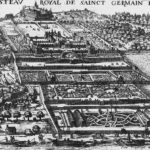
It’s annoying to have to change a location of scenes in the 7th draft of a novel. I’ve housed Louis XIV’s two mistresses in the old château in Saint-Germain-en-Laye: it’s an ancient castle-like fortress with a moat, turrets and all the trimmings.
I’ve visited it a number of times. There are two side-by-side chambers there that are said to have been those of Louise de la Vallière (the Sun King’s mistress #1) and Athénaïs, Madame de Montespan (the Sun King’s mistress #2). Voilá. And so it has been in both Mistress of the Sun and The Next Novel.
Gary McCollim, my wonderful historical consultant (familiar to many readers of this blog), pointed out that the King and Court were housed in Le Château Neuf, however—the “new” chateau (of which only remnants exist today).
Had I set my scenes in the wrong château? Did I need to rewrite? (Groan.)
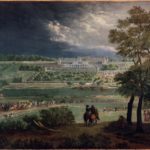
The New Château
The sprawling Château Neuf opened onto glorious view of the Seine river valley. It was enlarged and completed by Henry IV (who conveniently housed all his children—legitimate and illegitimate both—in the old castle).
Louis XIII, the Sun King’s father, died in the newer residence, and his sons were born there. Clearly, it was the royal residence.
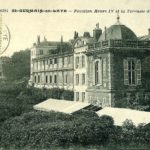
A timeline recap:
1648: During the French civil war called the Fronde, members of the royal family took refuge in Saint-Germain several times.
September 13, 1648, the Queen and her children stayed in the old chateau, possibly because it was more of a fortress, more secure. Neither residence was furnished, however, and the furnishings sent on from Paris were intercepted and looted.
A few months later, the King’s cousin, the Duchess of Montpensier, also came to Saint-Germain seeking asylum, installing herself at Château Neuf where “she lay in a wonderfully beautiful chamber in a ruined tower, well-gilded and large but with no glass in the windows and a meager fire.”
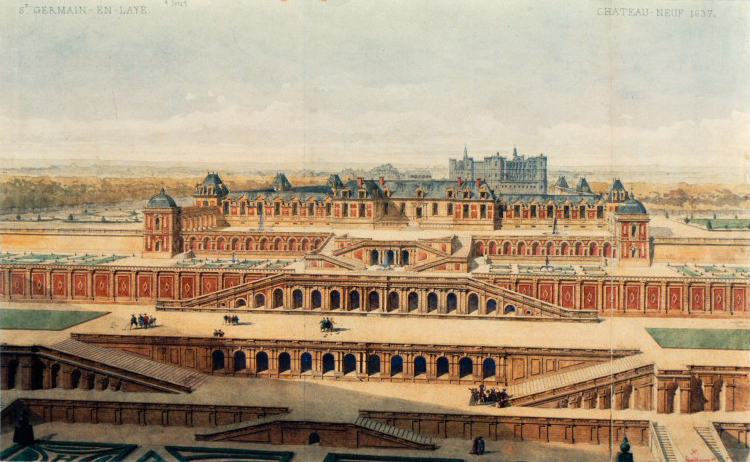
1660: One of the newer château’s retaining walls collapsed in 1660, and the King had the massive gardens renovated in 1662.
1668: the Court set off from the Château Neuf for the baptism of the Grand Dauphin in Sainte Chapelle of the Château Vieux.
1680: Mansart expanded and modernized the Château Vieux.
1682: the Court left Saint-Germain for Versailles, which became the seat of government.
1688: Louis XIV allowed the exiled James II of England to base himself at Saint-Germain. Some say James II took over the old castle, others that he and his court stayed in both.
So where does this all leave me, other than down the proverbial Research Rabbit Hole?
Do I relocate my scenes?
No: Because, with some rummaging around in my library, I discovered that two of the children Madame de Montespan had by the King were born in the old castle: Louis-August, Duc du Maine, in 1670, and Françoise-Marie, Mlle de Tours, in 1674.
All of which leads me to suspect that the mistresses—Louis de la Vallière and Madame de Montespan—were likely housed apart from the royal family in the old castle, at least some of the time.
However, like all research, this matter will be on-going … until publication, that is. Weigh in!

For an interesting paper on Le Château Neuf—including a floor plan (!) — see Le Château Neuf de Saint-Germain-en-Laye, une Villa Royale pour Henri IV by Emmanuel Lurin.
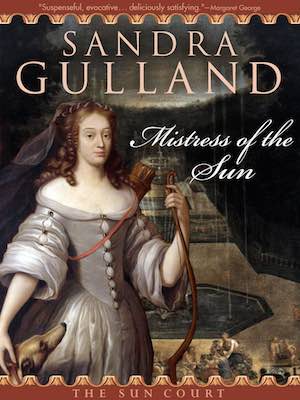
by Sandra Gulland | Apr 17, 2012 | Adventures of a Writing Life, Mistress of the Sun, Sandra Gulland INK |
{Cover of my e-book edition of Mistress of the Sun.}
In preparing to e-book publish my existing novels in the UK and beyond, I’ve had to revise, and then have them retyped and proofed. (Thank you so much, my FaceBook Fan Page readers!)
I, too, have had to carefully reread all of them, which has been quite an experience for me.
As well as timely.
In preparing to write a Young Adult novel about Josephine’s daughter Hortense, it has helped a great deal to re-read the Trilogy.
In writing This Bright Darkness (working title of The Next Novel) — a novel set in the Court of the Sun King — it’s been vital for me to reread Mistress of the Sun.
Firstly, I’ve recognized important changes I will need to make to This Bright Darkenss.
But secondly, I have had the opportunity to revise Mistress of the Sun. (The process never stops!)
At the Banff Book Discussion Weekend this last summer, a reader questioned the use of the word “shenanigan” in Mistress of the Sun.
Quite rightly! The first use of that word wasn’t until 1855.
I considered changing “No shenanigans—” to “No nonsense—”, but that didn’t quite convey the meaning I wanted. (Clorine is warning Petite not to have sex with old Gautier.)
Exploring possibilities in the on-line Oxford English Dictionary is one of the tasks I love best, so after some searching, I settled on another word. It’s quite old, quite rare and mysterious, but I think it gives more of a sense of Clorine’s meaning:
Clorine wagged a finger. “No chuffing—”
“Don’t worry!” Petite said, cutting her off before she said more.
Do you love it? It’s a word that goes back to 1200, and it means cheating, deceit, or falsehood. Plus, if you ask me, it sounds just a little bit rude.

Update: I admit I’m chuffed over how many have expressed interest in the word chuffing. (Thanks to Anita Davison for pointing out the modern English use of the word.)
Now, another change. Although “nickname” is a very old word, it feels modern to me — and, I suspect, to readers. Thus, I’m changing it to the dignified “sobriquet.”
by Sandra Gulland | Feb 4, 2011 | Adventures of a Writing Life, Recommended Books, Movies, Podcasts, etc. |

I just watched “Stage Beauty”—a wonderful movie about the changing world of 17th century theatre in London. I loved it. I believe I’ve found my perfect Petite in the actress Claire Danes.
There are a number of historical shifts and twists, nips and tucks, but all in the service of good drama. Somehow we forgive this in a movie, but wouldn’t in a novel. (Why is that?)
Although the movie captures the spirit of the theatre world of the time (I think), to have been perfectly accurate there would have been dandies with paid seats on the stage. This was distracting then, and it would have been distracting in this movie, as well.
I adored the representations of Nell Gwyn, Charles II (with all his dogs), Peyps. The costuming was terrific. Even though hats were not yet worn, I loved seeing them.
There are interesting differences between French and English theatre of this period, and the relatively late arrival of women on the English stage is one of them; women had long been on the stage in France. In France, male actors who played female roles did so for comic effect. Very different from the beautiful main character of this film.
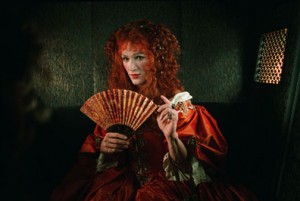
To see the movie trailer: click here. I had the pleasure of buying it on iTunes and watching it on my iPad.
by Sandra Gulland | Nov 11, 2010 | Baroque Explorations |
I’ve recently discovered Europeana, a great site for text, videos, and images. It’s especially great for portraits. Here, for example, are some portraits of Athénaïs de Montespan, some of which I’ve never seen before:

This one above is credited to Ernest and Mignard. One can see how plump she has become. Here is another by Mignard with a similar theme:

Athénaïs is often portrayed with her children, no doubt to secure her link to the King. This is another portrait by Mignard:

And another:
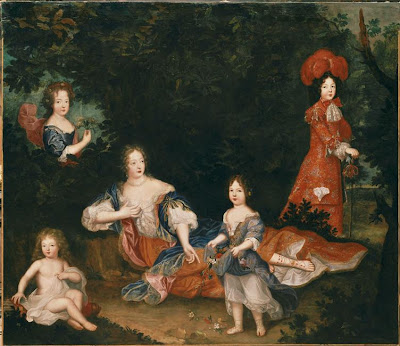
And this one by Charles de La Fosse:
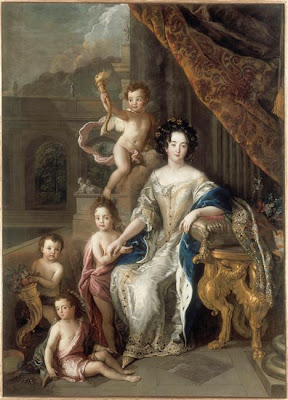
This image by Pierre Gobert is presumed to be of her, and I suspect it likely so:

Her lounging pose was unusual for the time; comfort was a new concept. Here again is a striking study by Nicolas Mignard:

This image of Athénaïs at her chateau at Clagny (Versailles now) is curious: bare legs!

This image, artist unknown (and previously thought to portray Louise de la Vallière) shows a younger Athénaïs with droopy eyes. Might this have been considered the come-hither look?

Here is another, likely even younger portrait, showing her unusual and slightly protruding eyes.

Here is a fashon plate, dated 1694. I doubt very much that Athénaïs would have been so slender at that time.

I could easily be on this site all day.
“Mme Guillotine” recently posted this very unusual and stunning portrait of Montespan on Instagram.
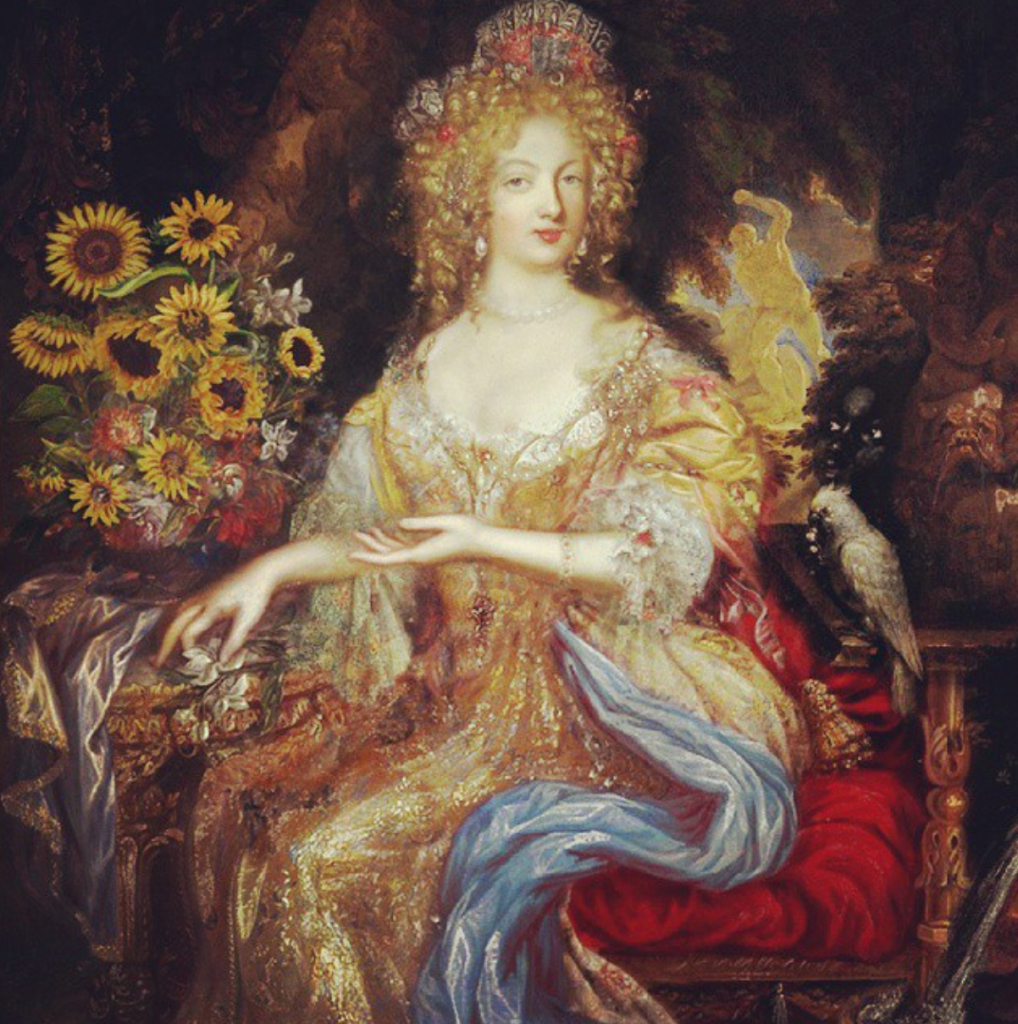
I’d love to know who the artist is. If you know, let me know!
by Sandra Gulland | Apr 19, 2009 | Adventures of a Writing Life |
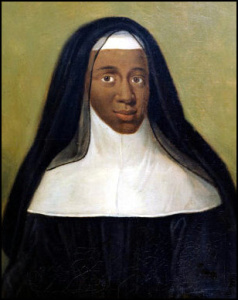
I’ve been researching the rumor of the “Black Nun of Moret” — allegedly the Queen’s baby by Nabo, her African dwarf. You can read the results of my research here: “The Queen’s mystery daughter.”
What struck me is that this would be a fine 2-week period in which to set a novel — there are a million dramas going on at this time:
Queen was expected to die: she begged the King to forsake his mistress, Louise de la Vallière.
Prayers and processions were ordered.
Meanwhile, former Minister Fouquet‘s trial was heating up. Fouquet’s wife provided the Queen with a secret remedy that in fact cured her — but does not, nonetheless, save Fouquet.
Fouquet is sentenced on December 20, but only condemned to perpetual banishment, which infuriates the King, who changes it to life imprisonment in Pignerol.
Meanwhile, a comet streaks across the night sky.
The Queen-mother collapses from breast cancer.
On December 26, the Queen’s “monster” baby dies at one month, and is buried at Saint Denis. The King is terribly grieved.
The offending (and suspected) dwarf Nabo, much beloved by the Queen, disappears — into the Bastille, some claim, to emerge as the Man in the Iron Mask.
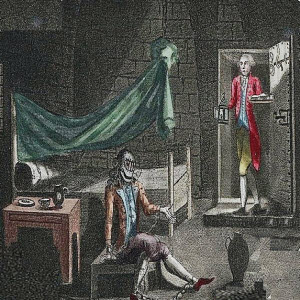
I love this last flight of fancy, but it is impossible, of course. If the Man in the Iron Mask were an African dwarf, we would have known.

Link to my essay, “The Queen’s mystery daughter”
Link to my Blog Tour details




![]()


















